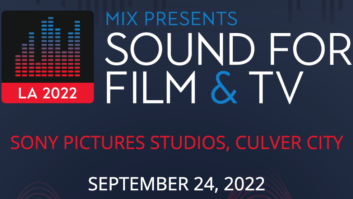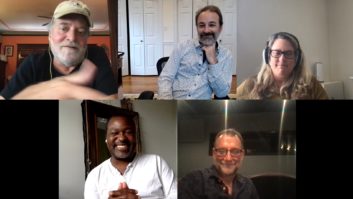MEDFORD, NJ—Opened in December 2016, Fellowship Alliance Chapel’s new Worship Center seats 1,700 worshippers on the main floor and another 500 in the balcony. To fully engage its congregation, the Worship Center leverages the latest in AV technology, including digital signage, LED wall technology and 4K video, along with an audio system centered around WorxAudio line array technology from PreSonus’ Commercial Division, Dante digital media networking technology, QSC’s Q-SYS DSP audio management system and more to create the overall audio infrastructure.
Horizon AVL System Integration of Blackwood, NJ, a design/build firm serving the commercial and worship markets, was contracted to handle the deployment of equipment at Fellowship Alliance Chapel’s new sanctuary. Joshua Kell, Horizon AV’s CEO, discussed the project.
“The new Worship Center measures approximately 150 feet wide by 175 feet deep and uses acoustical ceiling clouds to help manage sound reflections,” Kell reported. “Services are very contemporary, with music playing a vital role. We were involved in this project right from the start, with one key aspect of the design being able to facilitate upgrades and expansion as requirements warranted. This is precisely what led us to choose Audinate’s Dante and QSC’s Q-SYS systems.”
Except for conventional audio cabling from the stage area, the majority of audio is handled via Dante. At the stage area, there are 15 floor pockets for a total of 64 XLR inputs that feed directly to an Allen & Heath DM64 digital signal processor, which works in tandem with the Allen & Heath dLive S7000 digital control surface positioned at FOH. “Dante audio comes from the Allen & Heath mixing surface, and from there, everything is in the digital domain,” explained Kell. “This includes 12 channels of Shure ULX-D Series Dante-equipped wireless microphones. The Dante audio from the mixing station also feeds the QSC QSYS Core 510i processor for FIR (Finite Impulse Response) processing.”
“The Dante audio protocol enabled our team to quickly and effectively route audio to any location throughout the building—from the sanctuary’s FOH to the fill and under balcony areas, and even to the lobby,” Kell added. “Dante’s benefits are considerable, with cost and control foremost among them. The cost to install Cat cable and the ability to move high-quality audio makes Dante our first choice when designing a digital audio network.”
The loudspeaker system that Kell and his team deployed utilizes loudspeakers drawn from the WorxAudio product line of PreSonus’ Commercial Audio Division. Flown 27 feet over the front of the stage area, Kell and his team deployed 20 WorxAudio X1 2-way, high-efficiency, line array elements—10 each for the left and right sides. The two loudspeaker clusters face straight out into the sanctuary. For front fill, there are three WorxAudio X1M 2-way line array enclosures, located L-C-R and positioned in the face of the stage. Under balcony fill is handled by four WorxAudio V5M enclosures, evenly distributed across the room’s width.
Low frequency support is provided by nine WorxAudio TL118SSi-P subwoofers. Three enclosures are positioned underneath the stage while the left and right main loudspeaker clusters each have three flown behind them, positioned as an end-firing array.
AFMG’s FIRmaker technology, employed with the intention of improving spectral consistency, was implemented by Hugh Sarvis, chief designer/loudspeaker division at PreSonus. Working from a 2D design, the system was visualized in Ease Focus 3 to determine optimum placement and coverage. With the loudspeakers deployed, Sarvis re-measured all rigging heights, splay angles of the enclosures, plus distance to first row and back row seats.
“Once this data is in Ease Focus,” Sarvis explained, “we are ready to evaluate coverage and implement FIR filtering. I typically use up to six mics for testing—placing them on the floor as a ground plane measurement and positioning them starting at the front of the stage, with subsequent mic placements every doubling of distance for 5-, 10-, 20-feet, etc. With this system, I’m able to conduct a sweep and see all microphones simultaneously. Ease Focus 3 runs simulations of room coverage, exports the FIR filter to the computer, uploads the filter to a system controller such as Q-SYS and I continue measuring the room until the desired results are achieved. This process works quite well if implemented properly. We take pride in the fact that WorxAudio equipment is on the cutting edge of FIRmaker technology.”
Fellowship Alliance Chapel
Myfac.org
PreSonus
Presonus.com







